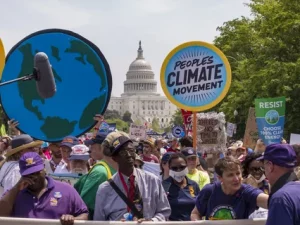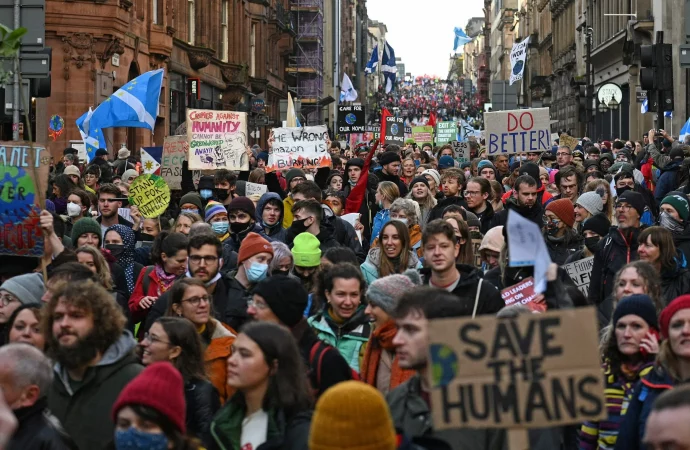In recent years, the global climate crisis has become an urgent and pressing issue, demanding immediate action from all sectors of society. Among the most vocal and active advocates for environmental change are the youth. Young people around the world are stepping up, using their voices, creativity, and energy to lead the charge in global
In recent years, the global climate crisis has become an urgent and pressing issue, demanding immediate action from all sectors of society. Among the most vocal and active advocates for environmental change are the youth. Young people around the world are stepping up, using their voices, creativity, and energy to lead the charge in global climate activism. This article explores the multifaceted role of youth in this critical movement, highlighting their contributions, challenges, and the potential impact of their efforts on the future of our planet.
Catalysts for Change: Youth-Led Movements

Image by : Yandex
One of the most prominent examples of youth-led climate activism is the Fridays for Future movement, initiated by Swedish teenager Greta Thunberg. In August 2018, Thunberg began skipping school on Fridays to protest outside the Swedish parliament, demanding stronger climate action. Her solitary strike quickly gained international attention, inspiring millions of young people worldwide to join her cause. The movement emphasizes the urgency of the climate crisis and calls for immediate and substantial policy changes to mitigate its impacts.
Youth-led movements like Fridays for Future have been instrumental in raising awareness about climate change and pressuring governments to take meaningful action. These movements leverage the power of social media to mobilize large numbers of people, organize global climate strikes, and amplify their message. Through their activism, young people are challenging the status quo and demanding accountability from political leaders and corporations.
Innovative Solutions and Grassroots Initiatives
Beyond protests and strikes, young climate activists are also involved in developing innovative solutions and grassroots initiatives to address environmental challenges. Many young entrepreneurs and innovators are creating sustainable technologies, launching eco-friendly startups, and promoting green practices within their communities. For instance, Boyan Slat, a Dutch inventor, founded The Ocean Cleanup project at the age of 18. His initiative aims to remove plastic waste from the oceans using advanced technologies, demonstrating the potential of youth-driven innovation in tackling environmental issues.
Grassroots initiatives led by young people are equally impactful. In various parts of the world, youth groups are engaging in reforestation projects, clean-up drives, and conservation efforts. These activities not only contribute to environmental restoration but also foster a sense of community and collective responsibility. By taking direct action, young activists are making tangible differences in their local environments and inspiring others to follow suit.
Education and Advocacy
Education plays a crucial role in empowering young people to become effective climate activists. Many youth-led organizations focus on raising awareness and educating their peers about climate science, sustainability, and environmental justice. Through workshops, seminars, and online campaigns, these organizations disseminate valuable information and equip young people with the knowledge and skills needed to advocate for change.
Advocacy is another key aspect of youth involvement in climate activism. Young activists are increasingly participating in policy discussions, engaging with decision-makers, and contributing to international forums such as the United Nations Climate Change Conferences (COP). Their presence in these spaces ensures that the voices of the younger generation are heard and considered in the formulation of climate policies. By advocating for stronger climate action, young people are influencing the political landscape and pushing for systemic changes that prioritize environmental sustainability.
Challenges and Barriers
Despite their passion and determination, young climate activists face several challenges and barriers. One significant obstacle is the lack of political and financial support. Many youth-led initiatives operate with limited resources and struggle to secure funding for their projects. Additionally, young activists often encounter resistance from established institutions and policymakers who may be reluctant to embrace their ideas or acknowledge the urgency of their demands.
Another challenge is the psychological toll of climate activism. The enormity of the climate crisis and the slow pace of progress can lead to feelings of frustration, anxiety, and burnout among young activists. Balancing activism with academic or professional responsibilities adds to the stress, making it essential to provide mental health support and create a supportive network for these young leaders.
The Power of Intergenerational Collaboration
While the youth are at the forefront of climate activism, intergenerational collaboration is crucial for achieving lasting change. Older generations possess valuable experience, resources, and influence that can complement the energy and innovation of young activists. By working together, different age groups can create a more comprehensive and effective approach to addressing the climate crisis.
Intergenerational collaboration can take various forms, such as mentorship programs, joint initiatives, and inclusive policy dialogues. For example, seasoned environmentalists can mentor young activists, providing guidance and helping them navigate the complexities of climate advocacy. Collaborative projects that involve both young and older participants can leverage diverse perspectives and expertise, resulting in more holistic and impactful solutions.
The Future of Youth Climate Activism

Image by : Yandex
The role of youth in global climate activism is continually evolving, with young people increasingly recognized as key stakeholders in the fight against climate change. As the climate crisis intensifies, the need for bold and innovative solutions becomes more urgent. Young activists are well-positioned to drive this change, bringing fresh ideas, unwavering commitment, and a sense of urgency to the movement.
To support and amplify the efforts of young climate activists, it is essential to provide them with the necessary resources, platforms, and opportunities. Governments, educational institutions, and organizations must invest in youth-led initiatives, facilitate access to decision-making processes, and create an enabling environment for youth participation. By empowering young people, we can harness their potential to create a more sustainable and resilient future for all.
In conclusion, the role of youth in global climate activism is indispensable. Young people are not only raising awareness and advocating for policy changes but also developing innovative solutions and leading grassroots initiatives to combat the climate crisis. Despite facing numerous challenges, their determination and resilience continue to drive the movement forward. By fostering intergenerational collaboration and providing adequate support, we can ensure that the voices of the youth are heard and that their contributions lead to meaningful and lasting environmental change.
















